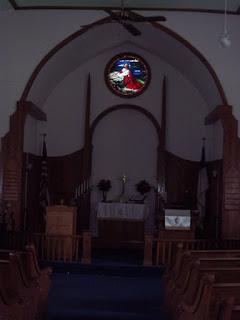are the intricate stained glass windows that they
have. I attend a United Methodist Church in Northeastern Pennsylvania. This is a small countryside church so we do not have many stained glass windows but we have one particular one that is right above the alter. In this stained glass window there is a picture of Jesus leaning on a rock and looking up to the sky in the direction of God. My church placed this specifically over the alter because we believe that Jesus is worshiping God in the picture. To us over the alter is perfect because that is a great place for us to see it while we are worshiping together. At Christmas time our church decorates around the stain glass window. We make it into a wreath but we also put Santas and reindeer around it. This meshes the commercial holiday in with religious holiday. Commercial christmas is not about the birth of Messiah like Christian christmas is. Commercial Christmas is about being with family and celebrating winter. It is also about giving gifts to the people you love. Commercialism brings religious holidays into the realm of an everyday human. Non-Chiristians celebrate Christmas now because it is now secularized.
Out of the four different types of material religion outlined by McDannell this stain glass
window fits into the art category.1 This was made as an artistic piece that then was just added to a church as a “decoration”. According to Emile Durkheim most religious objects fit into a binary of the sacred and the profane. The profane is the house, the workplace, children, workers, and women. The sacred are churches, temples, clergy and certain leaders. This stain glass window is in a church, which could make it sacred since a church is a sacred place but a stained glass window can be pretty much anywhere.
This is where the sacred versus profane debate becomes about context. When you take a material object out of context it loses some of its religiosity. If we saw a stained glass window in a pizza place we would still probably think of churches automatically because that is where we usually see stained glass windows but we would not necessarily see it as religious. A pizza place is a workplace so it is profane. So in context this stained glass window is religious but it is not necessarily sacred. The stain glass window in a pizza place can have many different reason to why it is there. It could have a saint on it which the owners can believe it is bringing a certain blessing to this business. In this case the stain glass window can be seen as profane because it is bringing something of religious power to the establishment even though it is a pizza place and not a church. This stained glass window is not anointing anything and it is not transcendental. But a church counts as a sacred place.2 The sacred versus profane debate is not a strict binary like Emile Durkheim believed. Sometimes the sacred and the profane mesh together. This is where context comes into play again.
1. Collen McDannell. Material Christianity: Religion and Popular Culture in America (New Haven: Yale University Press, 1995) 5.
2. Ibid.



No comments:
Post a Comment